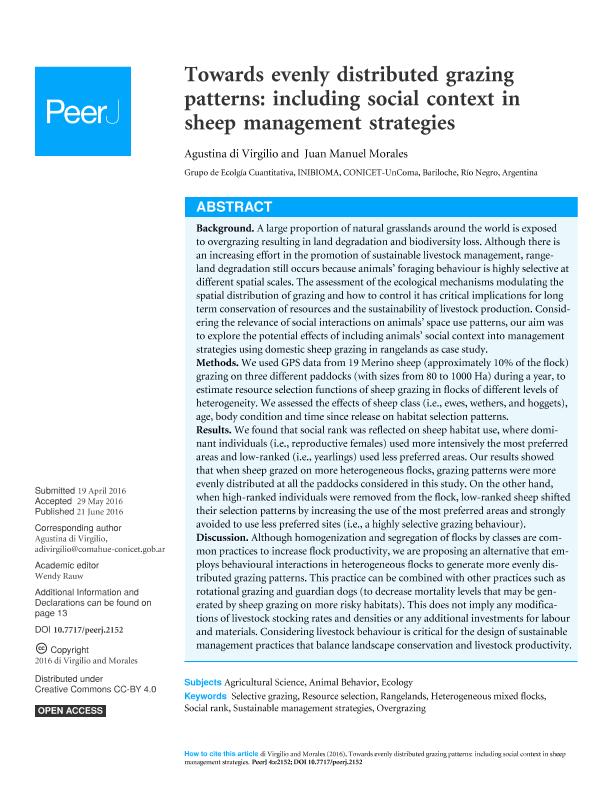Mostrar el registro sencillo del ítem
dc.contributor.author
Di Virgilio, Agustina Soledad

dc.contributor.author
Morales, Juan Manuel

dc.date.available
2019-02-11T21:26:29Z
dc.date.issued
2016-06-21
dc.identifier.citation
Di Virgilio, Agustina Soledad; Morales, Juan Manuel; Towards evenly distributed grazing patterns: Including social context in sheep management strategies; PeerJ; PeerJ; 6; 21-6-2016; 1-19
dc.identifier.issn
2167-8359
dc.identifier.uri
http://hdl.handle.net/11336/69943
dc.description.abstract
Background: A large proportion of natural grasslands around the world is exposed to overgrazing resulting in land degradation and biodiversity loss. Although there is an increasing effort in the promotion of sustainable livestock management, rangeland degradation still occurs because animals´ foraging behaviour is highly selective at different spatial scales. The assessment of the ecological mechanisms modulating the spatial distribution of grazing and how to control it has critical implications for long term conservation of resources and the sustainability of livestock production. Considering the relevance of social interactions on animals? space use patterns, our aim was to explore the potential effects of including animals? social context into management strategies using domestic sheep grazing in rangelands as case study. Methods: We used GPS data from 19 Merino sheep (approximately 10% of the flock) grazing on three different paddocks (with sizes from 80 to 1000 Ha) during a year, to estimate resource selection functions of sheep grazing in flocks of different levels of heterogeneity. We assessed the effects of sheep class (i.e., ewes, wethers, and hoggets), age, body condition and time since release on habitat selection patterns. Results: We found that social rank was reflected on sheep habitat use, where dominant individuals (i.e., reproductive females) used more intensively the most preferred areas and low-ranked (i.e., yearlings) used less preferred areas. Our results showed that when sheep grazed on more heterogeneous flocks, grazing patterns were more evenly distributed at all the paddocks considered in this study. On the other hand, when high-ranked individuals were removed from the flock, low-ranked sheep shifted their selection patterns by increasing the use of the most preferred areas and strongly avoided to use less preferred sites (i.e., a highly selective grazing behaviour). Discussion: Although homogenization and segregation of flocks by classes are common practices to increase flock productivity, we are proposing an alternative that employs behavioural interactions in heterogeneous flocks to generate more evenly distributed grazing patterns. This practice can be combined with other practices such as rotational grazing and guardian dogs (to decrease mortality levels that may be generated by sheep grazing on more risky habitats). This does not necessarily imply any modifications of livestock stocking rates and densities or any additional investments for labour and materials. Considering livestock behaviour is critical for the design of sustainable management practices that balance landscape conservation and livestock productivity.
dc.format
application/pdf
dc.language.iso
eng
dc.publisher
PeerJ
dc.rights
info:eu-repo/semantics/openAccess
dc.rights.uri
https://creativecommons.org/licenses/by/2.5/ar/
dc.subject
Heterogeneous Mixed Flocks
dc.subject
Overgrazing
dc.subject
Rangelands
dc.subject
Resource Selection
dc.subject
Selective Grazing
dc.subject
Social Rank
dc.subject
Sustainable Management Strategies
dc.subject.classification
Otras Ciencias Biológicas

dc.subject.classification
Ciencias Biológicas

dc.subject.classification
CIENCIAS NATURALES Y EXACTAS

dc.title
Towards evenly distributed grazing patterns: Including social context in sheep management strategies
dc.type
info:eu-repo/semantics/article
dc.type
info:ar-repo/semantics/artículo
dc.type
info:eu-repo/semantics/publishedVersion
dc.date.updated
2019-02-05T19:52:54Z
dc.journal.number
6
dc.journal.pagination
1-19
dc.journal.pais
Estados Unidos

dc.journal.ciudad
Nueva York
dc.description.fil
Fil: Di Virgilio, Agustina Soledad. Consejo Nacional de Investigaciones Científicas y Técnicas. Centro Científico Tecnológico Conicet - Patagonia Norte. Instituto de Investigaciones en Biodiversidad y Medioambiente. Universidad Nacional del Comahue. Centro Regional Universidad Bariloche. Instituto de Investigaciones en Biodiversidad y Medioambiente; Argentina
dc.description.fil
Fil: Morales, Juan Manuel. Consejo Nacional de Investigaciones Científicas y Técnicas. Centro Científico Tecnológico Conicet - Patagonia Norte. Instituto de Investigaciones en Biodiversidad y Medioambiente. Universidad Nacional del Comahue. Centro Regional Universidad Bariloche. Instituto de Investigaciones en Biodiversidad y Medioambiente; Argentina
dc.journal.title
PeerJ
dc.relation.alternativeid
info:eu-repo/semantics/altIdentifier/url/https://peerj.com/articles/2152/
dc.relation.alternativeid
info:eu-repo/semantics/altIdentifier/doi/http://dx.doi.org/10.7717/peerj.2152
Archivos asociados
